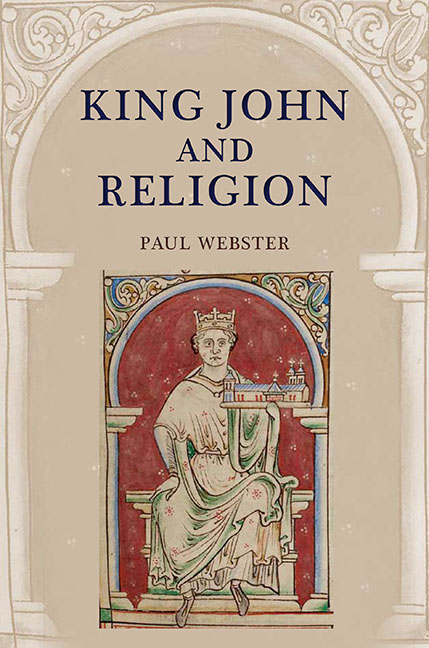Book contents
- Frontmatter
- Dedication
- Contents
- List of Illustrations
- Acknowledgements
- Abbreviations
- Introduction
- 1 The Mass
- 2 The Saints
- 3 Powerhouses of Prayer
- 4 Family
- 5 Charity and Almsgiving
- 6 Religion, Politics, and Reputation: The Interdict and King John’s Excommunication
- 7 Peace with the Pope: Diplomacy, Personal Religion, and Civil War
- 8 King John’s Deathbed and Beyond
- Conclusion
- Bibliography
- Index
- Other volumes in Studies in the History of Medieval Religion
- Frontmatter
- Dedication
- Contents
- List of Illustrations
- Acknowledgements
- Abbreviations
- Introduction
- 1 The Mass
- 2 The Saints
- 3 Powerhouses of Prayer
- 4 Family
- 5 Charity and Almsgiving
- 6 Religion, Politics, and Reputation: The Interdict and King John’s Excommunication
- 7 Peace with the Pope: Diplomacy, Personal Religion, and Civil War
- 8 King John’s Deathbed and Beyond
- Conclusion
- Bibliography
- Index
- Other volumes in Studies in the History of Medieval Religion
Summary
Seeking support from the saints, both in relation to everyday problems and for the future of the soul, was a fundamental aspect of medieval lay religion. For kings, the backing of the saints could be sought in the affairs of government and kingdom, and against opponents within and outside the realm. Such intercession could be sought as a potential buttress to authority, or for more day-to-day matters such as health and welfare. Despite this, John's interest in the cult of the saints stands first on Painter's list of ‘the more superficial forms’ of religious activity in which the king engaged. This assessment undoubtedly belittles the importance of this aspect of John's personal religion. He sought intercession from saints native to the kingdom of England and from the major Christian cults, doing so at individual cult centres, or by visiting several shrines in succession as he travelled. He also maintained a private relic collection that he could call upon during his near constant itineration.
Pre-eminent amongst the cults of late twelfth- and early thirteenth-century England was that of Thomas Becket. Whether or not Henry II sanctioned the murder of the archbishop of Canterbury in his own cathedral, the Angevins were tarred by association. John (born on 24 December 1166) had just turned four when Becket was killed, and was only seven at the time of his father's dramatic penance at Canterbury Cathedral (12–13 July 1174). He could not have initiated the royal response to the cult of St Thomas, but nonetheless inherited its legacy. After 1174, Henry II was a regular pilgrim to Becket's shrine, visiting each time he returned from the Continent (except in 1188, when the cathedral was under interdict). Henry also advertised his devotion to the saint he had inadvertently created, joining high-status pilgrims to Canterbury, as the cult blossomed into one of Europe-wide significance. These visitors included Henry II's son, Henry the Young King, King Louis VII of France, Count Philip I Flanders (twice), William of Blois archbishop of Rheims (twice), and Count Theobald V of Blois. The king of Scots, William I – captured at Alnwick almost at the moment when Henry II prayed at Becket's tomb at Canterbury in 1174 – founded Arbroath Abbey in honour of St Thomas (in 1178) and made pilgrimages to the saint's shrine.
- Type
- Chapter
- Information
- King John and Religion , pp. 37 - 60Publisher: Boydell & BrewerPrint publication year: 2015

